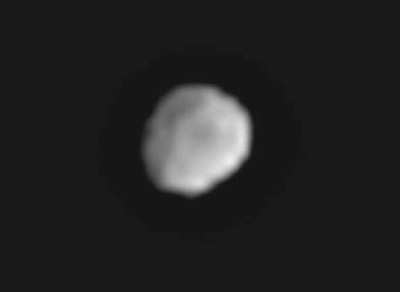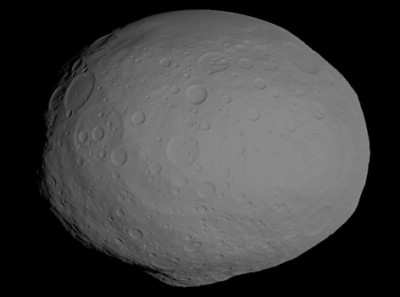Thu, Jun 16, 2011
Orbit Insertion Is Expected July 16
Scientists working with NASA's Dawn spacecraft have created a
new video showing the giant asteroid Vesta as the spacecraft
approaches this unexplored world in the main asteroid belt. The
video loops 20 images obtained for navigation purposes on June 1.
The images show a dark feature near Vesta's equator moving from
left to right across the field of view as Vesta rotates. Images
also show Vesta's jagged, irregular shape, hinting at the enormous
crater known to exist at Vesta's south pole.

Capture From NASA Video
The images were obtained by a framing
camera during a 30-minute period and show about 30 degrees of a
rotation. The pixel size in these images is approaching the
resolution of the best Hubble Space Telescope images of Vesta.
"Like strangers in a strange land, we're looking for familiar
landmarks," said Jian-Yang Li, a Dawn participating scientist from
the University of Maryland, College Park. "The shadowy spot is one
of those -- it appears to match a feature, known as 'Feature B,'
from images of Vesta taken by NASA's Hubble Space Telescope."
Before orbiting Vesta on July 16, Dawn will gently slow down to
about 75 mph. NASA is expecting to release more images on a weekly
basis, with more frequent images available once the spacecraft
begins collecting science at Vesta.
"Vesta is coming more and more into focus," said Andreas Nathues,
framing camera lead investigator, based at the Max Planck Institute
for Solar System Research, Katlenburg-Lindau, Germany. "Dawn's
framing camera is working exactly as anticipated."

NASA Image
The Dawn mission is managed by NASA's
Jet Propulsion Laboratory in Pasadena, Calif., for the agency's
Science Mission Directorate in Washington. Dawn is a project of the
directorate's Discovery Program, managed by NASA's Marshall Space
Flight Center in Huntsville, Ala. UCLA is responsible for overall
Dawn mission science. Orbital Sciences Corp. of Dulles, Va.,
designed and built the Dawn spacecraft. The framing cameras were
developed and built under the leadership of the Max Planck
Institute for Solar System Research in Katlenburg-Lindau, Germay.
The German Aerospace Center (DLR) Institute of Planetary Research
in Berlin made significant contributions in coordination with the
Institute of Computer and Communication Network Engineering in
Braunschweig. The framing camera project is funded by the Max
Planck Society, DLR and NASA. JPL is a division of the California
Institute of Technology in Pasadena.
More News
A Puff Of Smoke Came Out From The Top Of The Engine Cowling Followed By A Total Loss Of Engine Power On May 9, 2025, about 1020 mountain daylight time, an experimental amateur-buil>[...]
From 2022 (YouTube Edition): Jenny, I’ve Got Your Number... Among the magnificent antique aircraft on display at EAA’s AirVenture 2022 was a 1918 Curtiss Jenny painstak>[...]
Very High Frequency (VHF) The frequency band between 30 and 300 MHz. Portions of this band, 108 to 118 MHz, are used for certain NAVAIDs; 118 to 136 MHz are used for civil air/grou>[...]
“From approximately November 2021 through January 2022, Britton-Harr, acting on behalf of AeroVanti, entered into lease-purchase agreements for five Piaggio-manufactured airc>[...]
Microburst A small downburst with outbursts of damaging winds extending 2.5 miles or less. In spite of its small horizontal scale, an intense microburst could induce wind speeds as>[...]
 NTSB Prelim: Lee Aviation LLC JA30 SuperStol
NTSB Prelim: Lee Aviation LLC JA30 SuperStol Classic Aero-TV: Curtiss Jenny Build Wows AirVenture Crowds
Classic Aero-TV: Curtiss Jenny Build Wows AirVenture Crowds ANN's Daily Aero-Term (05.30.25): Very High Frequency (VHF)
ANN's Daily Aero-Term (05.30.25): Very High Frequency (VHF) Aero-News: Quote of the Day (05.30.25)
Aero-News: Quote of the Day (05.30.25) ANN's Daily Aero-Term (05.31.25): Microburst
ANN's Daily Aero-Term (05.31.25): Microburst




